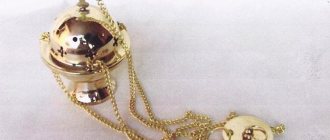The meaning and history of the pectoral cross, how to wear it correctly
Section: Christian symbolism
Label: Cross
Where did the tradition of wearing crosses come from? Why wear it? “I believe in God in my soul, but I don’t need a cross. It is not written anywhere in the Bible that one must wear a cross, and nowhere is it written that the first Christians wore crosses.” This or something like this is what people say who consider themselves Orthodox Christians, but do not express their faith in any way.
Most unchurched people do not have a Christian understanding of what a cross is and why it should be worn on the body. So what is a pectoral cross? Why does Satan hate it so much and does everything to ensure that no one wears it, or wears it simply as a meaningless decoration?
Every Christian from holy baptism to the hour of death must wear on his chest the sign of his faith in the crucifixion and Resurrection of our Lord and God Jesus Christ. We wear this sign not over our clothes, but on our body, which is why it is called a body sign, and it is called octagonal (eight-pointed) because it is similar to the Cross on which the Lord was crucified on Golgotha.
What is a pectoral cross?
“A weapon against demons and a symbol of eternal life” - this is how Orthodox Christians view the pectoral cross. It is put on after a person plunges into holy water three times during the sacrament of baptism and the original sin of Adam is washed away from him. From now on and forever, the pectoral cross tells fellow believers and angels about a person’s faith, that he will live according to the commandments of Christ and is no longer anyone’s slave on earth, but honors only God. Priest Anatoly Zygar writes in his articles that the pectoral cross is a symbol of commitment to God, faith and the triumph of Christ over the devil; it helps in sorrow, strengthens the spirit and protects from the machinations of the evil spirit.
Prayer to the Holy and Life-Giving Cross of the Lord
A short prayer to the Cross
Protect me, Lord, by the power of Your Honest and Life-giving Cross, and save me from all evil.
Prayer
May God rise again, and may His enemies be scattered, and may those who hate Him flee from His presence. Like smoke disappears, let them disappear; As wax melts in the presence of fire, so let demons perish on behalf of those who love God and sign the sign of the cross, and say in joy: Rejoice, Most Honest and Life-Giving Cross of the Lord, driving away and the demons have the power upon you of our Lord Jesus Christ, who descended into hell and trampled underfoot the power the devil, and who gave us Your Honest Cross to drive away every adversary. Oh, Most Honest and Life-Giving Cross of the Lord! Help me with the Holy Virgin Mary and with all the saints forever. Amen.
Translation: May God rise again, and may His enemies be scattered, and may all who hate Him flee from Him. As smoke disappears, so let them disappear; and as wax melts from the fire, so let the demons perish before those who love God and are marked by the sign of the cross and exclaim in joy: Rejoice, Most Honored and Life-Giving Cross of the Lord, driving away demons by the power of our crucified Lord Jesus Christ on you, Who descended into hell and destroyed the power of the devil and gave us You, Your Honest Cross, to drive away every enemy. Oh, Most Revered and Life-Giving Cross of the Lord, help me with the Holy Lady the Virgin Mary and with all the saints in all ages. Amen.
Read us conveniently on social networks:
Tags: why wear a cross, cross on the neck, cross on the neck, is it necessary to wear a cross, is it necessary for baptized people to wear a cross on their neck
Pectoral cross
Gold Lombard pectoral cross (late 6th - early 7th centuries)
The cross is worn on a cord or chain. Some people think that they also need to be sanctified, but this is a mistake - neither one nor the other needs sanctification, and the choice depends on the person’s habits.
History and origin of the pectoral cross
The custom of placing a pectoral cross on the neck of the newly baptized person along with Baptism did not appear immediately. In the first centuries of Christianity, they did not wear a cross, but rather wore medallions with the image of a slain Lamb or the Crucifixion. But the Cross, as the instrument of the salvation of the world by Jesus Christ, has been the subject of the greatest celebration among Christians from the very beginning of the Church. For example, the church thinker Tertullian (II–III centuries) in his “Apology” testifies that the veneration of the cross existed from the first times of Christianity. Even before the discovery of the life-giving Cross on which Christ was crucified in the 4th century by Queen Helena and Emperor Constantine, it was already common among the first followers of Christ to always carry an image of the cross with them - both as a reminder of the suffering of the Lord, and to confess their faith before others . According to the story of Pontius, biographer of St. Cyprian of Carthage, in the 3rd century, some Christians depicted the figure of a cross even on their foreheads; by this sign they were recognized during persecution and handed over to torture. The first Christians are also known to wear a cross on their chest. Sources from the 2nd century also mention him.
The predecessor of the pectoral cross is the so-called encolpion or encolpius (from the Greek έν κολπειώ - behind the bosom, on the chest), used in the ancient Christian church, as well as in ancient Rus'. Encolpions first had the shape of a four-sided box, empty inside; on the outside of them there was an image of a monogram of the name of Jesus Christ, and later - a cross of various shapes. In this box, particles of relics were kept, and in the era of persecution - lists of sacred Christian books. Two specimens of encolpium, which, according to archaeologists, date back to no later than the 4th century, were found in 1571 during the excavation of one of the Vatican graves.
Russian people swore allegiance on crosses, and by exchanging pectoral crosses, they became cross brothers. When building churches, houses, and bridges, a cross was laid in the foundation. There was a custom to cast many crosses from a broken church bell, which were especially revered. The Cross of Christ is a symbol of Christianity. For modern people, a symbol is just an identification mark. A symbol is like an emblem indicating something with which we are dealing. But the symbol has a much broader meaning than just the meaning of the emblem. In religious culture, a symbol is involved in the reality that it symbolizes. What is the reality that the Cross of Christ symbolizes for Christians?.. This reality: The Redemption of the human race, accomplished by the Lord Jesus Christ through the Death on the Cross.
The veneration of the Cross has always been understood by the Teachings of the Church as the worship of Jesus Christ in the light of His redemptive deed. The Cross of Christ, which Orthodox Christians always wear on their bodies, shows us and reminds us at what price our Salvation was purchased. For Christians, the cross is not just a sign. For Christians, the cross is a symbol of victory over the devil, a banner of the triumph of God. The cross reminds the believer of Christ, of the sacrifice the Savior made for us.
A pectoral cross is a cross given to every Orthodox Christian at baptism. Usually worn directly on the body (body). Can be metal or wood (especially often cypress)
. The tradition of wearing a cross implies its symbolic meaning: readiness to follow the Gospel: “if anyone wants to come after Me, let him deny himself, and take up his cross, and follow Me” (Mark 8:34). This tradition is not universal, although in Russia it is universal among Orthodox Christians. In the Russian Orthodox tradition, the inscription “Save and Preserve” is often placed on the back of the pectoral cross.
In Rus', pectoral crosses have been recorded since the middle of the 10th century (even before the official baptism of Rus' in 988) in the network of nodal points of the Old Russian state - in cities and churchyards. They were found mainly in druzhina burial complexes, which demonstrates the role of the druzhina in the processes of Christianization. The image of the crucifixion is already found on ancient Russian pectoral crosses, but relatively rarely.
Old Believers categorically reject pectoral crosses with the Crucifixion, believing that the depiction of a holy image likens a pectoral cross to an icon, the wearing of which on the body contradicts the rule of Basil the Great (see Nomocanon): “Anyone who wears any icon as an amulet must be subject to excommunication from communion for three years." At the same time, the Old Believers welcome the image, for example, of a vine on a woman’s cross as a reminder of the words of the psalmist: “Your wife is like a fruitful vine in the countries of your home” (Ps. 127:3). In the Soviet Union, for many, wearing a cross was a form of confession. After the end of persecution by the state, many again began to wear the pectoral cross. Wearing a cross along with icons, belts and even rings with texts of prayers can be superstitious if the wearer perceives it as one of the possible amulets.
The iconography of the Orthodox Crucifixion received its final dogmatic justification in 692 in the 82nd rule of the Council of Trula, which approved the canon of the iconographic image of the Crucifixion. The main condition of the canon is the combination of historical realism with the realism of Divine Revelation. The figure of the Savior expresses Divine peace and greatness. It is as if it were placed on a cross and the Lord opens His arms to everyone who turns to Him. In this iconography, the complex dogmatic task of depicting the two hypostases of Christ - Human and Divine - is artistically solved, showing both the death and the victory of the Savior.
Catholics, having abandoned their early views, did not understand and did not accept the rules of the Council of Trull and, accordingly, the symbolic spiritual image of Jesus Christ. Thus, in the Middle Ages, a new type of Crucifixion emerged, in which the naturalistic features of human suffering and the agony of execution on the cross became predominant: the weight of the body sagging on outstretched arms, the head crowned with a crown of thorns, the crossed feet nailed with one nail (an innovation at the end of the 13th century). The anatomical details of the Catholic depiction, while conveying the veracity of the execution itself, nevertheless hide the main thing - the triumph of the Lord, who defeated death and reveals to us eternal life, and concentrates attention on torment and death. His naturalism has only an external emotional impact, leading to the temptation of comparing our sinful sufferings with the redemptive Passion of Christ. Images of the crucified Savior, similar to Catholic ones, are also found on Orthodox crosses, especially often in the 18th-20th centuries, however, as well as iconographic images of God the Father of Hosts, prohibited by the Stoglavy Cathedral. Naturally, Orthodox piety requires the wearing of an Orthodox cross, and not a Catholic one, which violates the dogmatic foundations of the Christian faith.
Orthodox cross
The most common form of the Orthodox cross is an eight-pointed cross; the prayer “Save and Preserve” is most often written on the reverse side.
How to wear a pectoral cross correctly?
When worn, the cross should face the crucifix outward
If it is twisted, it needs to be corrected. If you want to wear an icon of a saint or the Virgin Mary around your neck, it should be combined with a cross, and you cannot replace it with a cross icon.
Do not wear over clothing
The pectoral cross should be worn under clothing. Only priests have the right to wear crosses over their clothes, and even then only in the Russian Orthodox Church. Among the Greeks, even priests wear a cross under their clothes. You cannot boast about an expensive cross, showing it to everyone - this is a sign of pride and boastfulness. The cross is worn secretly so that the pagans cannot desecrate the shrine. A priest from the village of Aleksino near Moscow, Archpriest Igor Fomin, believes that faith must be demonstrated through deeds and actions. He says that passers-by twice tried to spit on his crucifix - once in Moscow, and the second time in Jerusalem.
Never, never take it off?
If people of a different faith, pagans or atheists demand that you remove your cross, you should turn yourself in so as not to renounce Christ, says priest Pavel Konkov. He also stipulates that in exceptional cases it can be worn secretly on the body. But there are places in which you really have to remove the shrine - for example, during an operation or during an examination in a tomograph, where the patient should not have metal objects on him. In this case, it is better to remove the cross or put on a wooden cross on a cord in advance. During the operation, says Fr. Andrey Efanov, you can attach the cross to your wrist or take it off and entrust yourself to God. This is dictated by the safety of the patient and is not a renunciation of Christ. If you are asked to remove the cross on a water slide or in another place of entertainment, then you should think about whether you need this entertainment?
Treat like a shrine
A consecrated cross is a shrine, and should not be taken lightly. You cannot carry it in a bag, in a jeans pocket or on a bracelet. If you cannot wear it around your neck, you should attach it to the inside of your clothing. You cannot wear a cross and at the same time wear clothes with esoteric designs.
- satanic stars, demons or symbols of other religions. Only ignorant people can do this. Out of ignorance, bribes from them are smooth, but an Orthodox person knows that there is only one truth in the world - Christ, and must testify to this even with his appearance.
You cannot wear a cross and at the same time wear esoteric jewelry, badges, brooches in the form of cabalistic, esoteric signs or signs of the Zodiac.
By this, the Orthodox alienates himself from God and entrusts himself to completely different entities.
Tattoos that they made out of ignorance cause a lot of trouble to neophytes. Usually priests recommend bringing them together, and if this is not possible, covering them with clothes. A cross tattoo on the body is in no way a substitute for wearing a consecrated cross.
Superstitions are the main mistake
Ignorant people associate many superstitions with crosses.
- You can’t give it away (you’re giving it a hard fate)
- You cannot pick up a found cross (you take on someone else’s cross)
- You cannot wear the cross of a deceased person (you yourself will die)
- If the cross has darkened, this is a sign of illness: a lost cross means impending trouble, and a broken one generally turns into a “tragedy.”
Priest Andrei Efanov believes that this is magical thinking, which is unacceptable for a Christian. The fate of a thing cannot in any way influence a person’s life, which is in the hands of God.
If the cross is broken, you should take it to be repaired, and if it cannot be repaired, then you need to buy another cross.
You can and should give a cross; A cross consecrated at a special shrine can be given to a loved one. Godparents can and should give a cross to a child godson. The found cross should be raised so that the crucifix is not trampled underfoot. If you like the find and like it, you can consecrate it and wear it, and if the cross is old and broken, you can give it to the temple. It is worth doing the same with crosses that remain from the dead: they can be worn as a memory, they can be stored on a shelf with icons, or they can be taken to church.
The meaning of the pectoral cross
The cross is the greatest Christian shrine, a visible evidence of our redemption.
The cross, as an instrument of terrible and painful execution, thanks to the sacrificial deed of Christ the Savior, became a symbol of redemption and an instrument of salvation for all mankind from sin and death. It is on the Cross, through pain and suffering, death and Resurrection, that the Son of God accomplishes the salvation or healing of human nature from mortality, passion and corruption introduced into it by the fall of Adam and Eve. Thus, a person who wears the Crucifixion of Christ testifies to his participation in the suffering and feat of his Savior, followed by hope for salvation, and therefore the resurrection of a person for eternal life with God.
A pectoral cross is not a talisman or a piece of jewelry.
No matter how beautiful it may be, no matter what precious metal it is made of, it is first and foremost a visible symbol of the Christian faith. Orthodox pectoral crosses have a very ancient tradition and therefore are very diverse in appearance, depending on the time and place of manufacture.
Is it possible to wear two crosses?
The main question is why, for what purpose? If you were given another one, then it is quite possible to reverently keep one of them in a holy corner next to the icons, and wear one constantly. If you purchased another one, then wear it... A Christian is buried with a pectoral cross, so it is not passed on by inheritance. As for wearing a second pectoral cross somehow left behind by a deceased relative, wearing it as a sign of memory of the deceased indicates a misunderstanding of the essence of wearing a cross, which testifies to the Sacrifice of God, and not family relationships. A pectoral cross is not an ornament or an amulet, but one of the visible evidence of belonging to the Church of Christ, a means of grace-filled protection and a reminder of the Savior’s commandment: If anyone wants to come after Me, deny himself, and take up your cross, and follow Me... (Matthew .16:24).
Pectoral cross: rules of circulation and common misconceptions
The pectoral cross of an Orthodox Christian must be of a canonical shape (4, 6 or 8 ends) and consecrated. There is no special canonical teaching of the Church on wearing the cross. However, as already mentioned, traditionally the shrine is not worn for show, but under clothing.
The cross can be wooden or metal, on a string or a chain - it doesn’t matter. The main thing is to wear it with faith and reverence. It is not customary to remove the cross in everyday circumstances (when bathing, changing clothes, etc.). This is acceptable in special situations, such as during medical procedures. You don’t have to wear the same cross your whole life; you can change it. It is also not forbidden to give this shrine or receive it as a gift.
Archpriest Nikolai Markovsky warns against superstitions associated with the pectoral cross. For example, some people are convinced that dropping or losing it will bring bad luck. The priest notes:
“People work, rush about business, play sports. It may happen that a person loses his pectoral cross. You can't attach any significance to this. You need to buy another one from the icon shop. Put on a new one and wear it with faith and prayer.”
If the cross on the neck has darkened, it means that the metal has oxidized. One should not look for mysticism in this either. Another example of superstition: supposedly you cannot pick up, much less carry, a cross that someone has lost. It is believed that this will change fate and “hang” other people’s sins on a person. Father Nikolai reminds us that in Christianity there are no concepts of predestination and fate. Man has free will and builds his own life. The priest calls not to allow the shrine to be trampled underfoot. The found cross should be picked up and taken to the temple.
How to purchase a pectoral cross
In our store you will find a good selection of crosses, rosaries and other Orthodox paraphernalia
View store
Add a comment
Lyudmila | February 5th, 2021 at 14:20
Comment
Not long ago I started looking for a cross, it was a gift for my birthday. I wanted it to be beautiful and to please its owner, that is, me) Frankly speaking, I had my eye on it here for a long time, but I thought, what if I find something more interesting? I couldn’t find it) A cross made of cypress wood is the most natural and real! I like how the eyelet is made in it, it is not a standard type, it matches the cross. That is, the whole product looks very harmonious due to this. I'm very glad that I bought it. I advise you to buy!
Kirill Muromsky | April 15th, 2021 at 08:24
Comment
The cross is the greatest Christian shrine, a visible evidence of our redemption. In the service for the Feast of the Exaltation, the Church glorifies the tree of the Cross of the Lord with many praises: “The Cross is the guardian of the entire universe, the beauty of the Church, the power of kings, the affirmation of the faithful, the glory of angels and the plague of demons.” A pectoral cross is given to a baptized person who becomes a Christian and is constantly worn in the most important place (near the heart) as an image of the Cross of the Lord, an external sign of an Orthodox Christian. This is also done as a reminder that the Cross of Christ is a weapon against fallen spirits, having the power to heal and give life. That is why the Cross of the Lord is called Life-Giving! He is evidence that a person is a Christian (a follower of Christ and a member of His Church). That is why it is a sin for those who wear a cross for fashion without being a member of the Church. Consciously wearing a cross on the body is a wordless prayer, allowing this cross to demonstrate the true power of the Archetype - the Cross of Christ, which always protects the wearer, even if he does not ask for help or does not have the opportunity to cross himself. When performing the sacrament of Baptism, the priest puts a cross on the baby, which from that moment becomes the inseparable companion of the new member of the Church. It is not customary to remove a cross when bathing or changing clothes (in the old days there were even wooden crosses in the baths, which were worn in the steam room instead of their own). Unfortunately, there are also “knowledgeable” advisers: nurses, neighbors, friends who authoritatively convince the mother to remove the cross from the child: they say he is still small, he will get tangled in the ribbon, he will rub the skin, etc. There are canonical forms of crosses - four, six -, eight-pointed; with a semicircle below and others. Each line has a deep symbolic meaning. In Rus', eight-pointed crosses are more accepted, on the back of which, according to tradition, the inscription “Save and Preserve” is written. Saint Demetrius of Rostov wrote back in the 18th century: “We reverence the Cross of Christ not by the number of trees, not by the number of ends, but by Christ himself, whose Most Holy Blood was stained with Him. Displaying miraculous power, any Cross does not act by itself, but by the power of Christ crucified on it and by invoking His Most Holy Name.” There are no rules about the material for crosses. Obviously, precious metals are also acceptable here, because for a Christian nothing can be more valuable than a cross—hence the desire to decorate it. But, of course, simple wooden or metal crosses are closer in spirit to the Cross of the Lord. There is also no fundamental difference between a chain and a braid: it is important that the cross is held firmly. The cross should not be removed, including during washing and sports activities. Lay people wear a cross on their body under their clothes, without deliberately showing it off. In the first centuries of Russia’s adoption of Christianity, crosses were worn not on the body, but on top of clothing “as clear indicators of Christian baptism.” Later, only bishops had the right to wear a cross over their clothes until the 18th century, and even later - priests. The priestly pectoral cross is called a pectoral cross (“persi” in Church Slavonic means “chest”). Along with the pectoral, priests also wear a pectoral cross. Russian people swore allegiance on crosses, and by exchanging pectoral crosses, they became cross brothers. When building churches, houses, and bridges, a cross was laid in the foundation. There was a custom to cast many crosses from a broken church bell, which were especially revered. Taking off one's cross or not wearing it has always been understood as apostasy. Over the 2000-year history of Christianity, many people have suffered for their faith, for refusing to renounce Christ and take off their pectoral cross. This feat has been repeated in our time.
Kostya | August 7th, 2021 at 14:08
Comment
I was baptized as a child, do I have to wear a cross? Explain why it must be worn?
Lisa | May 1st, 2021 at 05:14
Comment
The cross is a sign of a person’s belonging to the Church of Christ. In symbolic form, the pectoral cross serves to glorify the Redemptive Sacrifice of Christ, which He offered for us on the Cross. The cross also symbolizes the bearing of the cross, about which the Lord Himself said: “Whoever wants to come after Me, let him deny himself, and take up his cross and follow Me” (Mark 8:34) ... “Did the first Christians wear crosses? “The cross, as the instrument of the salvation of the world by Jesus Christ, has been the subject of greatest celebration among Christians from the very beginning of the Church. The Fathers of the Church called this honoring the apostolic tradition. In the first three centuries it belonged to the area of disciplinae arcanae, that is, to the circle of those Christian beliefs and rituals that were kept secret from the pagans, and therefore we have very few external sources mentioning this custom. According to the story of Pontius, biographer of St. Cyprian of Carthage, in the 3rd century, some Christians depicted the figure of a cross even on their foreheads; by this sign they were recognized during persecution and handed over to torture. The first Christians are also known to wear a cross on their chest. Sources from the second century also mention him.” Why didn't the apostles wear such crosses? “...We cannot say this with certainty, since there is evidence from the beginning of the second century that the martyrs wore an image of a cross on their chests. At the same time, the apostles had no need to wear the distinctive sign of a Christian, since throughout their lives they continually showed themselves to be Christians...” The Apostle Paul writes: “I do not want to boast, except in the cross of our Lord...” (Gal. 6:14) . Ap. Paul does not disdain, but rather boasts in the cross. Phil. 3:18: “For many of whom I told you, and now I tell you even with tears, walk as enemies of the cross of Christ.” In Eph. 2:16
Anastasia | August 7th, 2021 at 18:09
Comment
The cross is imprinted on the heart of a baptized person. Wearing a cross is an ancient tradition of the Church. The first Christians, before they began to wear a cross, painted a cross on their foreheads or wore an image of a fish - a secret sign. This is how they got to know each other. After all, communication with each other is the basis of the Church. Christians were persecuted and destroyed. Wearing a cross was dangerous. But Christians did not take off their crosses, but on the contrary, they wore them with reverence and joy. Many died. Then came the victory of Christianity - and now wearing the cross became safe. But people continued to wear crosses in memory of their martyrs. After all, these were their grandparents, great-ancestors, in short. Now we also wear crosses in memory of the persecuted but eternal Church and of Christ Himself. I carry my cross like the keys to my house. Having been baptized, I am now a resident of the Kingdom of God. On my chest are the keys to the House. After all, every person needs a Home, a Motherland.










